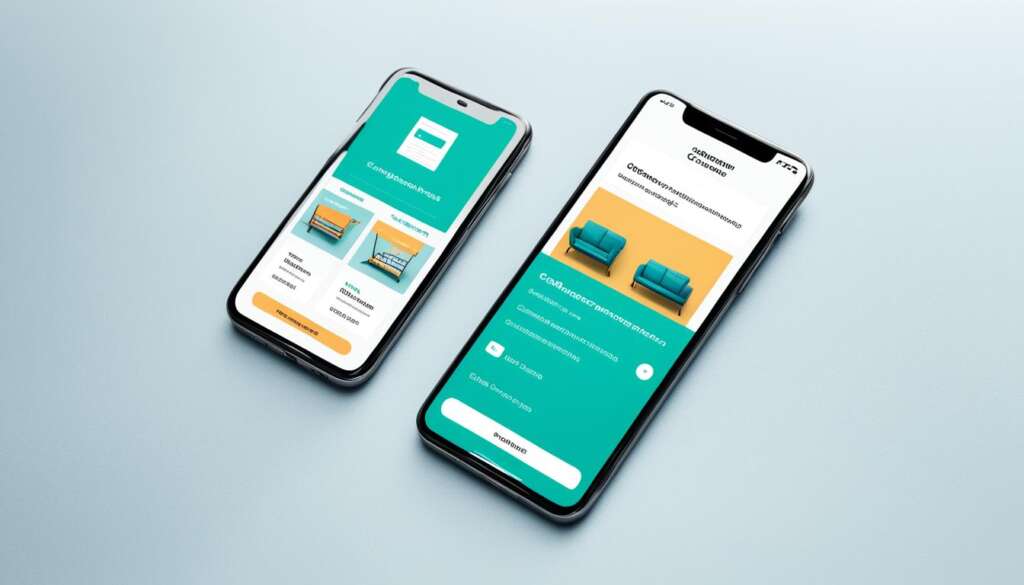Table of Contents
Mobile shopping has become the norm, with users expecting a seamless and user-friendly web interface. In fact, about 75% of customers admit to buying goods through their phones. This highlights the importance of having a mobile-friendly website to attract potential clients. Optimizing for conversions on mobile platforms is crucial, as delays and complex layouts can lead to high bounce rates. Components such as a one-page checkout, proper product information, and security badges are essential for building trust and facilitating decision-making on mobile devices.
Mobile conversions are the key to success in the world of e-commerce. To maximize mobile sales and turn visitors into committed buyers, it’s essential to optimize your website for mobile devices. Responsive design is the foundation for meeting customer expectations, ensuring a consistent and adaptable viewing experience across various screen sizes and orientations. By embracing responsive design and other best practices, businesses can unlock the full potential of mobile conversions and create a shopping experience that customers will appreciate and return to.
Importance of Optimizing for Conversions on Mobile Platforms
When it comes to mobile platforms, delays and complex page layouts can be detrimental to your e-commerce conversions. User behavior on mobile devices is different from desktops, and it’s crucial to understand these nuances to maximize your conversion rates.
One of the key factors in optimizing conversions on mobile platforms is the checkout process. By implementing a one-page checkout, you can reduce the number of steps and simplify the process for your customers. This not only improves the user experience but also minimizes the chances of abandonment due to lengthy or complicated checkout procedures.
In addition to streamlining the checkout process, providing proper product information is essential for building trust and facilitating decision-making. Mobile users have limited screen space, so it’s crucial to present concise yet informative descriptions, specifications, and customer ratings. This enables users to make quick and informed purchasing decisions, ultimately optimizing conversions.
“By optimizing the placement and visibility of security badges and trust seals, you can reassure customers about the safety of their data and payments, thus improving their confidence in making a purchase.”
Security is a major concern for mobile users, and it’s important to address those concerns. By optimizing the placement and visibility of security badges and trust seals, you can reassure customers about the safety of their data and payments, thus improving their confidence in making a purchase.
Understanding user behavior on mobile platforms is crucial for tailoring the mobile e-commerce journey to their needs and increasing conversions. By analyzing user data, you can gain insights into their preferences, habits, and pain points, allowing you to optimize your mobile platform accordingly. This includes optimizing the layout, navigation, and design elements to provide a seamless and user-friendly experience.
Overall, optimizing for conversions on mobile platforms requires a deep understanding of user behavior, strategic placement of elements, and an emphasis on simplicity and trust. By prioritizing these aspects, you can ensure a smooth mobile shopping experience and increase your conversion rates.
| Key Factors for Optimizing Conversions on Mobile Platforms | Benefits |
|---|---|
| Implement a one-page checkout | Reduced steps and simplified process for customers |
| Provide proper product information | Boosts trust and facilitates decision-making |
| Optimize placement and visibility of security badges and trust seals | Reassure customers about the safety of their data and payments |
| Understand user behavior on mobile platforms | Tailor the mobile e-commerce journey to their needs and increase conversions |
The Mobile-First Approach to E-commerce
The mobile-first approach to e-commerce involves developing websites or designs that prioritize mobile screens. With the increasing market share of mobile devices, it is essential for e-commerce businesses to focus on mobile optimization. By ensuring a flawless purchasing process on mobile screens, businesses can enhance the customer experience and increase conversion rates.
Successful examples of mobile-first e-commerce platforms include Amazon and Shopify, which optimize their sites for different mobile phone screen sizes to provide a uniform and pleasurable purchase environment.
10 Best Practices for Mobile Ecommerce Conversions
To boost mobile sales and turn mobile visitors into committed buyers, e-commerce businesses should implement the following best practices:
1. Implement Responsive Design
Responsive design enhances user convenience by ensuring that websites adapt seamlessly to different screen sizes and orientations. This ensures a consistent and user-friendly experience across all devices, ultimately driving conversions.
2. Optimize Load Times and Performance
Slow load times and poor performance can lead to revenue reduction and high bounce rates. Prioritize optimizing website speed and performance to provide a smooth and enjoyable mobile shopping experience, increasing the likelihood of conversions.
3. Build Email Lists
Email lists are a valuable direct communication and marketing tool. By collecting email addresses from mobile visitors, businesses can personalize their marketing efforts, targeting potential customers with tailored offers and promotions that drive conversions.
4. Utilize Mobile Payment Options
Streamline the shopping process by offering mobile payment options such as mobile wallets and one-click checkout. These features simplify the payment process, making it more convenient for users to complete their purchases and increasing conversion rates.
5. Integrate Mobile SEO Strategies
Optimize your website for improved visibility in mobile search results by implementing mobile SEO strategies. This includes optimizing page titles, meta tags, and content to align with mobile search queries, increasing the chances of attracting potential customers and driving conversions.
6. Adapt Content for Mobile Consumption
Ensure that your website’s content is easily consumable on mobile devices by utilizing concise and scannable paragraphs, bullet points, and relevant headings. This improves readability and enables users to quickly find the information they need, leading to increased engagement and conversions.
7. Utilize Mobile Analytics Tools
Gain valuable insights into mobile user behavior by integrating mobile analytics tools. These tools provide data on user interactions, preferences, and navigation patterns, allowing businesses to optimize their mobile experiences based on real-time data and ultimately increase conversions.
8. Integrate Email Lists with Other Marketing Channels
Integrate your email lists with other marketing channels, such as social media and retargeting campaigns, to create a cohesive customer experience. Consistent messaging across different channels helps reinforce your brand and encourages conversions across various touchpoints.
9. Prioritize User Reviews and Ratings
User reviews and ratings are incredibly influential in the decision-making process. Displaying these prominently on your mobile e-commerce site builds trust and can significantly impact conversion rates. Ensure that users can easily access and contribute to these reviews.
10. Enhance Mobile Customer Support
Provide easy access to customer support on your mobile e-commerce site, such as live chat or a dedicated helpline. Prompt and efficient customer support improves user satisfaction, resolves queries or issues quickly, and ultimately boosts conversions.
By implementing these best practices, e-commerce businesses can optimize their mobile platforms for maximum conversions, providing a user-friendly experience that drives sales and increases revenue.
Meeting Customer Expectations in Mobile Shopping
Today’s shoppers have high expectations when it comes to mobile shopping experiences. They demand a seamless, intuitive, and user-friendly interface that rivals that of a desktop website. Any frustration caused by poor mobile optimization can result in shopping cart abandonment and lost sales. In order to meet these customer expectations and deliver a satisfying mobile shopping experience, businesses need to prioritize responsive design.
Responsive design serves as the foundation for meeting customer expectations in mobile shopping. It ensures a consistent and adaptable viewing experience across various screen sizes and orientations, providing users with a user-friendly interface that works seamlessly. By implementing responsive design techniques, businesses can optimize their websites for mobile shopping, allowing customers to easily navigate through products, make purchases, and complete transactions.
But what exactly is responsive design? It’s an approach to web design that focuses on creating websites that automatically adjust and adapt to different screen sizes and devices. This means that whether a customer is accessing a website on a smartphone, tablet, or desktop computer, the website will respond and adapt accordingly, providing an optimal viewing experience.
With the prevalence of mobile shopping, businesses must prioritize responsive design in order to cater to their customers’ needs and expectations. Without it, customers may struggle to navigate through a website, view product details, or complete a purchase, resulting in frustration and ultimately, lost sales.
Responsive design not only enhances the user experience, but it also helps businesses build trust and credibility with their customers. When customers encounter a user-friendly interface that works seamlessly, they are more likely to trust the brand and feel confident in making a purchase. This trust and confidence can lead to increased customer loyalty and repeat business.
Benefits of Responsive Design in Mobile Shopping:
- Improved user experience
- Increased customer trust and confidence
- Reduced shopping cart abandonment
- Higher conversion rates
- Consistent branding across devices
- Better search engine visibility
By prioritizing responsive design and meeting customer expectations in mobile shopping, businesses can create a positive shopping experience that keeps customers coming back for more. With a user-friendly interface that adapts to their needs, customers can browse, shop, and complete transactions with ease, resulting in increased conversions and revenue.
The Role of Mobile Optimization in Search Engine Rankings
Mobile optimization plays a crucial role in search engine rankings, particularly since Google adopted mobile-first indexing. Websites that are mobile-friendly are rewarded with higher search engine rankings, providing an invaluable advantage in a digital marketplace where customers often begin their shopping journeys with a search engine query.
Mobile optimization not only enhances user experiences but also improves a business’s visibility, making it essential for staying competitive.
| Benefits of Mobile Optimization | Impact on Search Engine Rankings |
|---|---|
| 1. Improved user experience | Higher search engine rankings |
| 2. Faster loading times | |
| 3. Effortless navigation | |
| 4. Adaptability across devices | |
| 5. Enhanced accessibility |
By prioritizing mobile optimization, businesses can create mobile-friendly websites that provide seamless experiences for their customers. This leads to higher search engine rankings, making their websites more visible and attracting a larger audience.
To illustrate the importance of mobile optimization, consider the example of a customer searching for a specific product on their mobile device. If two websites are competing for the same search term, but one has a mobile-friendly design while the other does not, the mobile-friendly website is more likely to rank higher in search engine results. This is because search engines recognize the importance of mobile experiences and prioritize websites that cater to mobile users.
As the number of mobile users continues to rise, businesses cannot afford to overlook the significance of mobile optimization. It is crucial to ensure that websites are designed and optimized for mobile devices to improve search engine rankings and attract potential customers.
Mobile optimization is not only about improving search engine rankings; it is also about providing a user-centric experience. When websites are optimized for mobile devices, users can easily navigate, find information, and complete transactions, leading to increased customer satisfaction and higher conversion rates. Therefore, mobile optimization should be a top priority for businesses seeking to thrive in today’s mobile-driven world.
Conclusion
Maximizing mobile conversion rates is essential for e-commerce success in today’s digital landscape. By implementing a responsive design, businesses can ensure that their websites adapt seamlessly to different screen sizes and provide a user-friendly experience. Optimizing load times and performance is crucial as delays can lead to high bounce rates and lost sales. Building email lists allows for direct communication and targeted marketing, while utilizing mobile payment options streamlines the shopping process and improves customer satisfaction.
Integrating mobile SEO strategies is vital for improving visibility in mobile search results and driving organic traffic to the website. By meeting customer expectations and prioritizing mobile optimization, businesses can create a seamless mobile-first experience that builds trust and encourages conversions. Embracing a mobile-first approach to e-commerce is no longer an option but a necessity in today’s mobile-centric world.
To unlock the full potential of mobile conversions, businesses must prioritize responsive design, optimize load times, build email lists, utilize mobile payment options, and integrate mobile SEO strategies. By doing so, they can create a shopping experience that customers will appreciate and return to, ultimately driving higher conversion rates and boosting e-commerce success.
FAQ
Why is mobile optimization important for e-commerce conversions?
Mobile optimization is crucial for e-commerce conversions because delays and complex layouts on mobile platforms can lead to high bounce rates. By optimizing for conversions on mobile devices, businesses can attract potential clients and increase sales.
What components are essential for building trust and facilitating decision-making on mobile devices?
Components such as a one-page checkout, proper product information (including descriptions, specifications, and customer ratings), and security badges are essential for building trust and facilitating decision-making on mobile devices.
What is the mobile-first approach to e-commerce?
The mobile-first approach to e-commerce involves developing websites or designs that prioritize mobile screens. By optimizing for mobile devices, businesses can enhance the customer experience and increase conversion rates.
What are some best practices for mobile e-commerce conversions?
Best practices for mobile e-commerce conversions include implementing responsive design, optimizing load times and performance, building email lists for direct communication and targeted marketing, utilizing mobile payment options, and integrating mobile SEO strategies for improved visibility in mobile search results.
Why is meeting customer expectations in mobile shopping important?
Meeting customer expectations in mobile shopping is important because customers expect a seamless, intuitive, and user-friendly interface. Frustration caused by poor mobile optimization can lead to shopping cart abandonment and lost sales.
How does mobile optimization impact search engine rankings?
Mobile optimization plays a crucial role in search engine rankings, particularly since Google adopted mobile-first indexing. Websites that are mobile-friendly are rewarded with higher search engine rankings, providing a competitive advantage in the digital marketplace.













